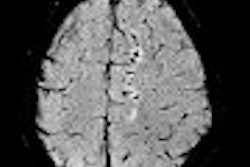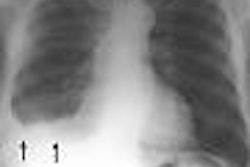When facing the possibility of valve replacement surgery, a truly accurate determination of a patient's aorta helps decide the final treatment. But the most common imaging options for this scenario have not made this easy.
Now, a modest new study has found that cardiac magnetic resonance (CMR) planimetry with steady-state free precession (SSFP) is a more feasible and tolerable option in many cases, and also more sensitive and specific than other noninvasive methods for evaluating severe stenosis.
The study, co-authored by Dr. Udo Sechtem of the cardiology department at Robert Bosch Medical Center in Stuttgart, Germany, was recently published in the British Cardiac Society's Heart journal (August 2004, Vol. 90:8, pp. 893-901).
The appropriateness of valve replacement surgery depends on the patient's symptoms, as well as imaging-derived functional and hemodynamic variables such as aortic valve area (AVA), the authors note.
While transthoracic echocardiography (TTE) with the continuity equation is most often used for noninvasive evaluation of AVA, its use is limited by "poor acoustic windows and erroneous calculations caused by annulus calcification or eccentric jet morphology," they wrote.
Many facilities therefore turn to semi-invasive transesophageal echo (TEE). However, it is not well-tolerated by patients, and direct TEE planimetry cannot be accomplished in patients with heavy calcification or a poor acoustic window.
Another option is cardiac catheterization, but the results are affected by cardiac function and aortic regurgitation. It's also an invasive procedure with a risk of complications.
With the need for a better alternative in mind, the researchers evaluated the comparative performance of cardiac MR, but specifically performed with steady-state free precession. "In contrast to older gradient-echo-based imaging protocols, SSFP is widely independent of hemodynamic status, flow turbulence, and valvar calcification," the authors wrote.
The study included 44 consecutive patients admitted to the Stuttgart center for a decision regarding possible valve replacement. All had known aortic stenosis established by echocardiography. Most had symptoms such as systolic murmur, exertional dyspnea, syncope, chest pain, or a history of cardiac failure.
All the patients were slated for examinations using TTE, catheterization, TEE, and CMR, generally in that order. None of the four modalities was successful in evaluating every patient in the study, however.
The CMR imaging was performed with ECG gating and SSFP pulse sequences (true fast imaging with steady-state precession; echo time 1.58 msec, repetition time 47.4 msec, flip angle 60 degrees, and voxel size 1.8 x 1.3 x 5 mm at a field of view of 340 mm) on a 1.5-tesla scanner (Magnetom Sonata, Siemens Medical Systems, Erlangen, Germany).
Two patients couldn't undergo CMR because of metallic implants, and two more were precluded by severe claustrophobia. With cardiac cath, the aortic valve could not be crossed by a catheter via the transseptal approach in five patients. Heavy calcification scuttled the TEE planimetry of nine patients, and a poor acoustic window prevented the AVA assessment of three patients by TTE.
Thus, the overall feasibility for the modalities in evaluating this patient group was 91% for CMR, 89% for cardiac cath, 80% for TEE, and 93% for TTE.
On the plus side for CMR, even patients with severe calcifications could be evaluated with that modality by all observers. There was also no interobserver variability in evaluating patients with isolated stenosis versus combined stenosis and regurgitation, or in evaluating patients with normal versus low left ventricular ejection fraction.
Using catheterization as the standard, the sensitivity of CMR was 78%, TEE was 70%, and TTE was 74%. Specificity was 89% for CMR, 70% for TEE, and 67% for TTE.
The researchers also cited CMR's low intraobserver and interobserver variability as an indication of the reliability and reproducibility of their approach. They said their findings were consistent with a similarly sized comparative study of CMR for aortic stenosis published last year in the Journal of the American College of Cardiology (August 6, 2003, Vol. 42:3, pp. 519-526).
While conventional gradient-echo CMR could not provide reliable AVA measurement due to artifacts and calcifications, the authors wrote, "(our) results clearly indicate that the use of new SSFP sequences almost completely eliminates these technical limitations."
"CMR planimetry of AVA with steady-state free precession is a new powerful diagnostic tool, particularly for patients with uncertain or discrepant findings by other modalities," the authors concluded.
By Tracie L. ThompsonAuntMinnie.com staff writer
September 20, 2004
Related Reading
Stress MRI tops echo for coronary disease detection, May 26, 2004
MR tagging identifies LV torsion-to-shortening ratio in AS, March 4, 2004
MRI ‘more robust’ for assessing aortic root in connective tissue disorders, March 1, 2004
Myocardial ischemia, viability made apparent with MR, February 6, 2004
Copyright © 2004 AuntMinnie.com



.fFmgij6Hin.png?auto=compress%2Cformat&fit=crop&h=100&q=70&w=100)




.fFmgij6Hin.png?auto=compress%2Cformat&fit=crop&h=167&q=70&w=250)











